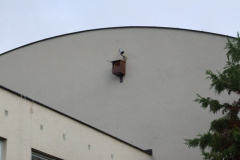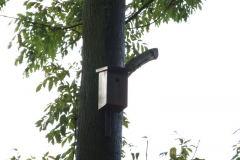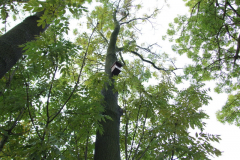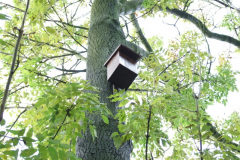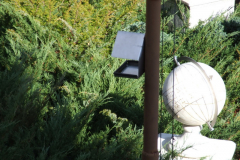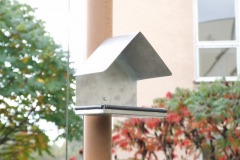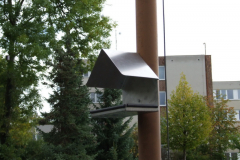
All Life in the Air
Common Swift (Apus Apus)
Apus means „legless“ in Latin. The swift has got really very short legs, not at all obvious in flight. They do not allow him walking or hopping gait so typical for many of our small birds, but just hanging on rough vertical walls or the bark of trees. However swifts hardly ever need feet, as they spend almost a lifetime in the air and are the only birds able to fly and sleep.
Its sleep is kind of in short sections. The bird ascends to a height of 1 km (this altitude is typical of flying blimps for example) to sleep and relax for a few minutes while falling. It falls into a second sleep, in which half the brain is inactive, but the second controls its movement and the surroundings.

Looking for the perfect flyer, we have found it in this species. The swift spends most of its life in the air. At active flight it reaches speeds of 90 to 200km / hr. It is the fastest of our birds. It is reported that after flying out of the nest for the first time young swifts will not touch the ground for two years. In the air they hunt for food, bathe in the rain, and even sleep and copulate in the sky. After two years, sexually mature birds find their companion or mate and begin to build a nest of material caught in the air (feathers, straws, fur). Female and male pairs are faithful for life.
This clever aeronaut had originally inhabited inaccessible cliffs. However more than a hundred years ago, almost without exception, these birds moved close to humans. They nest mainly on higher structures, such as churches, towers, including blocks of flats. They build their nests in various cavities (often as loopholes in the walls, ventilation ducts, dark corners between beams, etc.) They nest in the same site every year.

Booth for swifts
…is characterized by a mainly longitudinally mounted opening (an oval one with a width of about 7cm and height of 3.5cm) – swifts‘ wings are wide and such a hole allows them to fly into the booth more easily.
The booth was hung under the roof top of the school pavilion. It is equipped with a camera that monitors the swift’s life. The image is transmitted to the project web http://ipep.gymcheb.cz/.
Summer Guests
The Common Swift is a strictly migratory species. It winters in tropical areas of Africa, south of the Sahara. It comes to our zone for only 3 months to hatch eggs and raise the young. It remains with us for the shortest of all migratory birds.
They arrive in April-May and begin nesting within a few days. They mostly lay 2-3 pure white eggs, which are hatched by both parents in turn (18 – 20 days). On cold days and nights both parents warm the clutch simultaneously. As swift food depends on weather a lot, they hunt far away from their breeding sites in bad weather. Fortunately the young are adapted to such conditions. They can go without food for a long time lest their development be disrupted.
During starvation the animals are able to inhibit their metabolism and reduce their body temperature to survive for even two to three weeks. They will reduce the number of breaths from 40 to 10 per minute and lower their body temperature to be only about 2 to 3 degrees higher than the surrounding air.
Swifts leave the temperate zone in late July or early August. At that time, most of these birds, including juveniles, disappear, later only a single straggler, or birds stretching across our territory from Northern latitudes breeding sites to be seen. The reasons for their early passage are not yet precisely known, because during August there are still enough flying insects and small spiders drifting through the air (so-called aeroplankton), which is the swift’s staple food, so they would definitely not be threatened with starvation. Yet most swifts fly „in time“ regardless of the weather being.

Source: http://5kg.sweb.cz/ptaci/rorys-obecny_10.jpg
The range of sickle swifts‘ slender wings is 40-44cm. Their whole body is dark brown to black, only their chin is a lighter cream.
Within the entire bird kingdom you will not find another group that would be better adapted to almost permanent stay in the air. The swift’s body is perfectly aero-dynamic, their wing is narrow and long. The remiges are considerably harder than other birds‘, so that it is no problem for these birds to withstand the almost constant flapping produced by their flying muscles. And those are due to special physiological adaptations of almost endless energy. Daily the swift flies its 1000 kilometers, which is more than the distance from Cheb to Paris.
According to the law on protection of nature and landscape, the Common Swift is protected as an endangered species.


